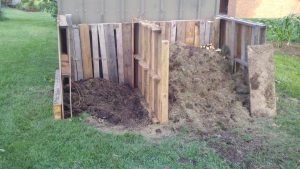Composting has many benefits, specifically for your home garden. Follow these steps to keep your process safe and effective:
 Step one, build a compost bin
Step one, build a compost bin
I decided to build a three bin system to allow for the amount of compost I will need over the years. So far two bins are constructed and a third will be added next year as I need it. The idea is that during the growing months, you add green and brown matter to the first bin. This bin fills up over a year and then you repeat on the second bin (repeat again the third year). After two years you will have dark, rich soil that can be used. I built my first two bins from old pallets donated by a local electrical company that just ‘throws them away’ and leftover scraps from the playhouse construction just completed. The bins only have to look as good as you want them to look. There should be air gaps left to allow for the materials to get needed oxygen. I allowed for enough space in the bins to hopefully hold a years worth of garden and kitchen scraps.
How your composting bins work
A composter is usually a contained area that holds plant matter or very specific items like egg shells or paper. You add green matter and brown plant matter, mix them well, and let nature do the rest. Microorganisms will feed off the matter and produce more of themselves to keep the process going. The pile will heat up, sometimes as high as 140 degrees, and disinfect the pile itself from the heat. After the process is over (takes around 2 years) you are left with a dark soil that can be used for soil amendment, ground cover, or to enhance your garden.
What does composting need?
Water is very important to the process (I like to let the rain clouds do the work)
Nitrogen from greens
Carbon from browns
Oxygen – from turning the pile and from the sides of the bin (don’t use a closed bin without holes).
Heat – produced by itself, but slows down in the cold winter.




